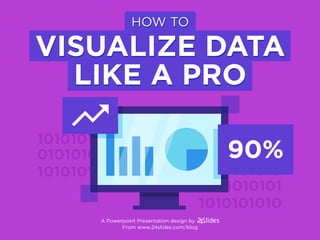
Data Visualization Guide for Powerpoint Presentations
- 1. 90% A Powerpoint Presentation design by From www.24slides.com/blog
- 3. DATA VISUALIZATION INVOLVES INTERPRETING DATA SIMPLE, EASY TO UNDERSTAND INFORMATION USING VISUALS
- 5. VISUAL DATA HELPS US TO THINK AND COMMUNICATE
- 6. GOLDEN RULESGOLDEN RULES OF CREATING A DATA VISUALIZATION POWERPOINT PRESENTATION
- 7. A PICTURE TELLS A STORY BETTER THAN A THOUSAND WORDS COULD
- 8. BY VISUALIZING YOUR DATA, YOU CAN COMMUNICATE YOUR STORY MORE EFFECTIVELY
- 9. 4 KEY QUESTIONS FOR SUCCESSFUL DATA VISUALIZATION WHAT IS THE STORY YOUR DATA IS TRYING TO TELL? WHAT CHART TYPE WILL DISPLAY YOUR DATA IN THE SIMPLEST AND MOST EFFICIENT WAY? WHO IS YOUR AUDIENCE? WHAT TYPE OF DATA DO YOU WANT TO EXPLAIN?
- 10. WHAT IS YOUR STORY? All data tells a story. Data visualization makes the story easy to understand Are sales up or down? Is the birthrate on the increase? Are expenses under control?
- 11. WHAT TYPE OF DATA DO YOU WANT TO EXPLAIN? Quantitative data deals with numbers and things you can measure objectively. This can be: POPULATION STATISTICS SALES & EARNINGS BUDGET FIGURES EXPENSES ETC
- 12. DATA TYPES Nearly every organization has quantitative information to collect, dissect, understand and present Data visualization allows you to present this data in a simple visual way so that it makes sense at a glance Quantitative data is ideal for visualization.It summarizes the data’s essential characteristics allowing to disregard exceptions
- 13. WHO IS YOUR AUDIENCE? Are you presenting to a board of directors, healthcare professionals, prospective investors?
- 14. KNOW YOUR AUDIENCE Your audience should influence how you visualize your data. Understanding how your audience best digests data will influence which chart types you will use
- 15. Get to the point. As much as storytelling is an art, knowing what your audience need to know from the numbers is critical. Choose the simplest and clearest chart type which allows you to get straight to the point KNOW YOUR AUDIENCE
- 16. CHOOSE THE VISUAL AID THAT WILL SPEAK DIRECTLY TO YOUR AUDIENCE
- 17. Each chart type is suited to telling a different story. Common chart types include: WHAT CHART TYPE WILL DISPLAY YOUR DATA EFFICIENTLY? PIE CHARTS BAR GRAPHS LINE GRAPHS SCATTER GRAPHS BUBBLE GRAPHS HEAT MAPS
- 18. WHY VISUALIZE WITH GRAPHS GRAPHS ALLOW YOU TO GET STRAIGHT TO THE POINT A SIMPLE GRAPH CAN TELL A STORY OF A THOUSAND WORD
- 19. GRAPHS ALLOW YOU TO SHOW TRENDS PATTERNS EXCEPTIONS A DCB E HGF
- 20. DATA VISUALIZATION USING PIE CHARTS Perfect for displaying proportions and percentages in a part-to-whole relationship %
- 21. Less is more: limit the number of categories to 5 or less PIE CHART TIPS 5 CATEGORIES
- 22. Clearly label percentages to avoid misinterpretation of the segment sizes PIE CHART TIPS 25% 75%
- 23. YES GOOD Order slices so that they are quickly understood PIE CHART TIPS
- 24. Avoid the use of 3D pie charts, they make the data more difficult to understand PIE CHART TIPS GOODUMM...
- 25. BAR GRAPH Use a bar graph to show groups comparison. They can be either horizontal or vertical
- 26. Always start value axis at zero BAR GRAPH TIPS
- 27. Use a consistent scale BAR GRAPH TIPS 10 15 20 A YES 10 15 30 A NO!
- 28. LINE GRAPH A line graph uses a line to show time-series relationships of continuous data. They are great for showing trends and changes over time A B C
- 29. Use a maximum of 4 lines when comparing LINE GRAPH TIPS
- 30. Use solid lines and not dotted lines LINE GRAPH TIPS YES UMM..
- 31. Label each line separately LINE GRAPH TIPS = A = B = C
- 32. Use a correct scale for the graph LINE GRAPH TIPS GOOD 20 40 60 80 UMM.. 20 35 40 60
- 33. SCATTER GRAPH Scatter graphs can be used to show the relationship between two variables. Perfect to use for large data sets such as population or epidemiology studies.
- 34. Use lines to show trends & relationships. SCATTER GRAPH TIPS
- 35. Use as few lines as possible SCATTER GRAPH TIPS
- 36. Always start with the Y-axis at 0. SCATTER GRAPH TIPS 0 20 40 24 48 72 X Y 0
- 37. WARNING: Be wary of creating a non-existent cause-effect relationship SCATTER GRAPH TIPS ?
- 38. BUBBLE GRAPH By using different size or colour of bubbles, a bubble graph can show relationships between data in a very clear manner. Bubble graphs can be used to show 2, 3 or 4 variables on the same graph.
- 39. Use simple shapes. Circles work best. BUBBLE GRAPH TIPS PICK ME!
- 40. Size bubbles appropriately. BUBBLE GRAPH TIPS 60.000 100.000
- 41. Use clear and visible labels. BUBBLE GRAPH TIPS
- 42. HEAT MAP Heat maps are great for showing geographical or complex data. By using different shades of color, comparisons can be clearly shown 0 A i ii iii iv v vi B C D E F 10 20 30 40 50
- 43. Use simple color gradients HEAT MAP TIPS
- 44. GOOD NOPE! Keep patterns to a minimal HEAT MAP TIPS
- 45. USE CLEAR MAP BOUNDARIES HEAT MAP TIPS
- 46. WHAT YOU HAVE LEARNT YOU SHOULD KNOW MORE ABOUT DATA VISUALIZATION BY NOW
- 47. 4 KEYS TO DATA VISUALIZATION TELL A STORY CHOOSE THE RIGHT VISUAL (CHART TYPE) FOR EFFECTIVE COMMUNICATION SPEAK TO YOUR AUDIENCE EXPLAIN DATA SIMPLY
- 48. % VISUALIZE DATA TO TELL A BETTER STORY FOR YOUR AUDIENCE VISUALIZE DATA TO TELL A BETTER STORY FOR YOUR AUDIENCE
- 49. Get 2 free slides Get a monthly subscribtion Need help visualizing your big data?
